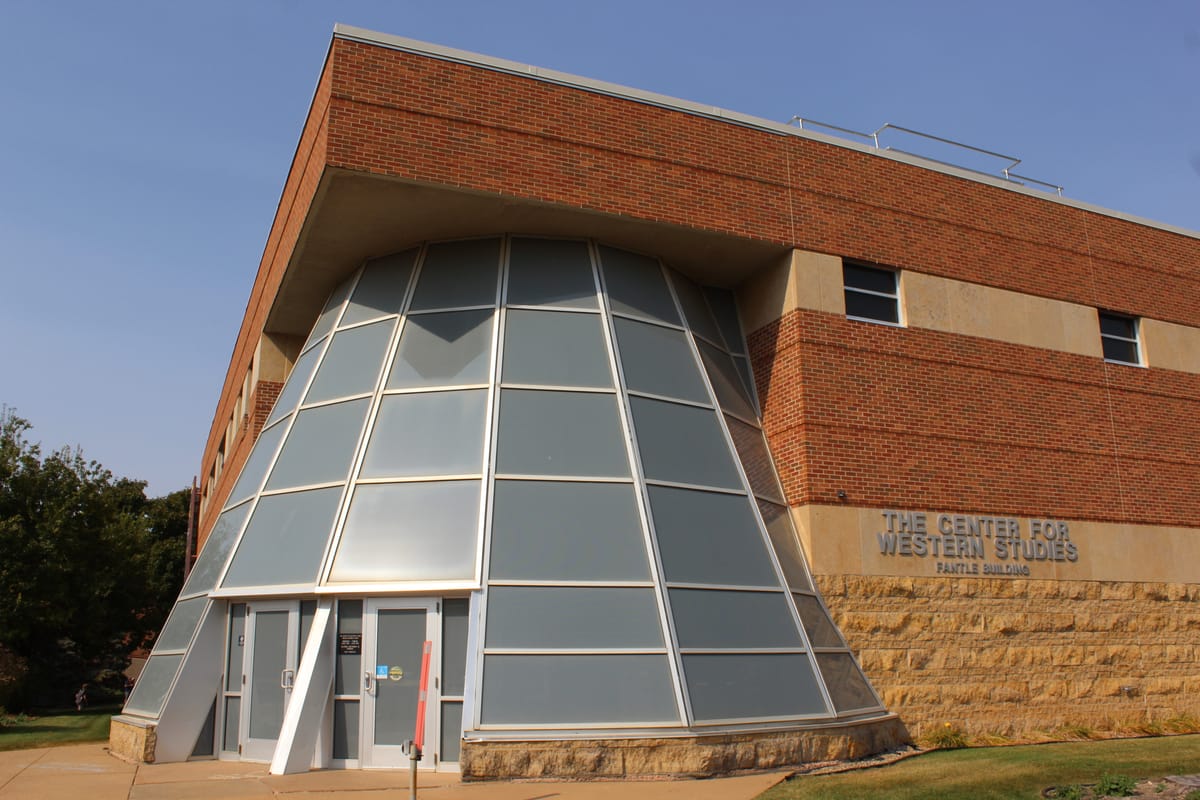Reading Augustana: “Place,” The Center for Western Studies

Thanks to CWS Executive Director Harry Thompson for his help with this installment of Reading Augustana.
When one “reads” Augustana, some parts of our institution jump out for obvious consideration, such as the academic buildings, the Commons, the Elmen and Midco Arena.
However, one building often gets overlooked by students, faculty and visitors alike. In recent years, it is even sometimes cut from campus tours for the sake of time.
Luckily, “Reading Augustana” does not forget the Center for Western Studies (CWS): In fact, the class is held in a CWS conference room. To kick off the course’s series of guest speakers and campus visits, students simply learn about where they are.
The CWS intentionally uplifts the history of the place in which we live and the indigenous peoples who previously resided in this region.
The majority of the lower floor serves as an event space, but it also contains museum-like exhibits dedicated to the history of regional indigenous tribes and the University itself. A carefully managed storage space for archival collections of historical artifacts and documents dominates the upper floor.
Throughout the year, the first floor’s event space also doubles as an art gallery. Sometimes its walls bear pieces from the upstairs archival collections – other times, the CWS sponsors art shows that prioritize regional artists.
For instance, the most recent art show in the building was “Buffalo: Master of the Plains,” a sequel to 2022’s show “Stallions and Mares: Legends of the Plains.” “Buffalo” ran from April 3 to Sept. 27 and featured works from more than 30 regional artists.
Even the architecture of the building says volumes about what it prioritizes. Many window ledges and the lower parts of the external walls are made of Kasota limestone, which comes from nearby Minnesota – an intentional regional choice. Inside, the pale brown carpet sports a wavy pattern that aims to invoke imagery of tall grass rippling under prairie winds.
Most visibly, the southernmost structure of the CWS was designed to emulate a tipi, a traditional dwelling for many Northern Plains tribes. Embedded in the tile floor is a prayer circle, which former Augustana professor Martin Brokenleg consulted on. A member of the Rosebud Sioux tribe, Brokenleg also performed a traditional Indigenous blessing ceremony on the space at the building’s completion.
All of this careful design speaks to the importance of the task the CWS takes on: to do justice to this place and all of its history.
The Center for Western Studies is done a disservice when we, the current inhabitants of this place, overlook it. Civitas finds a home base in this space for a reason: To be a responsible citizen – the kind of student which the program seeks to create – one must understand the place in which they live.
Next time you are near, consider dedicating five minutes of your time to the education the CWS offers. Explore the exhibit spaces, and learn something new. Admire the art on the walls. Ask a staff member a question. You will be better for it.
I close this installment of “Reading Augustana” with the CWS’ land acknowledgment, which recognizes the many tribes who have lived in this region throughout history – some far before Augustana was even an idea. I encourage you to give it careful attention and to have curiosity about the history of the place you now call home.
The Center for Western Studies at Augustana University acknowledges the Northern Plains as the ancestral home of many Indigenous peoples, including the Arapahoe, Arikara, Cheyenne, Crow, Dakota, Hidatsa, Iowa, Mandan, Omaha, Oto, Pawnee and Ponca. Beginning in the mid-1700s, this region also became the home of the Oceti Sakowin (Seven Council Fires), an alliance that consisted of the Santee, Yankton, Yanktonai and Teton Lakota. They are commonly known as the Sioux by non-native people. The seven tribes now occupy nine different reservations in South Dakota: Cheyenne River Sioux Tribe, Crow Creek Sioux Tribe, Flandreau Santee Sioux Tribe, Lower Brule Sioux Tribe, Oglala Sioux Tribe, Rosebud Sioux Tribe, Sisseton-Wahpeton Oyate, Standing Rock Sioux Tribe and the Yankton Sioux Tribe.



